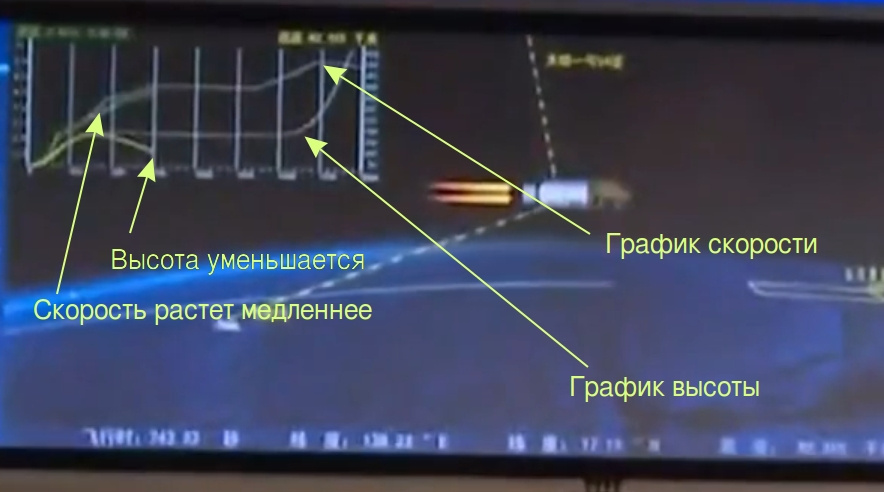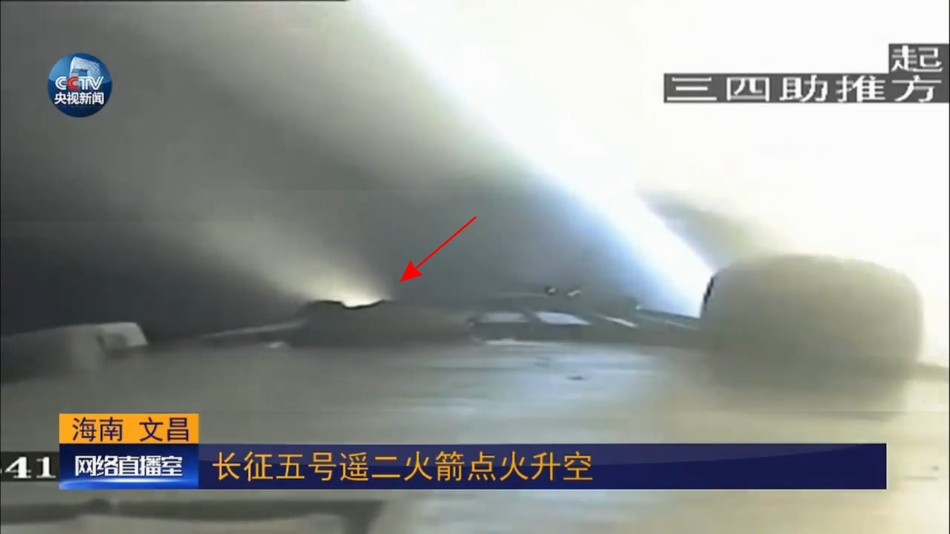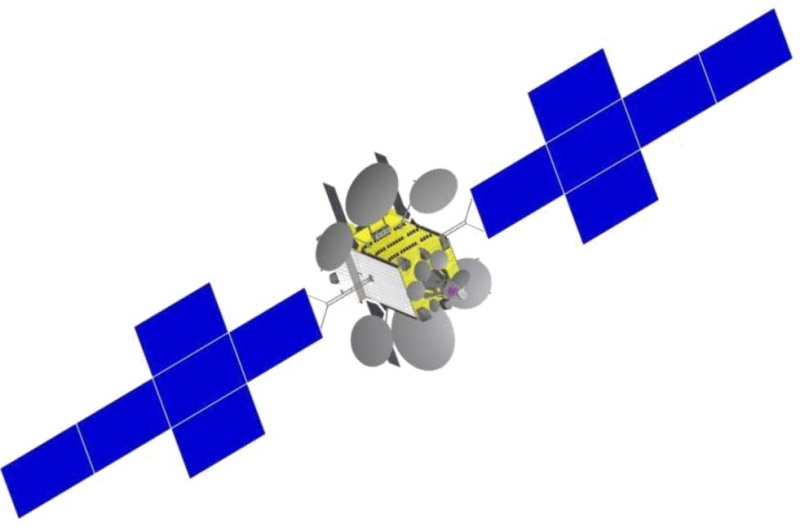Emergency start-up of the "Great March-5"
At 11:23 UTC on Sunday, the second launch of the “Great campaign-5” rocket with the Shijian-18 telecommunications satellite took place. Some time later, oddities appeared in the broadcast, then it was interrupted, and the launch was declared unsuccessful. What happened?

The rocket "Great campaign-5", photo 9ifly.cn
Start could be tracked by several broadcasts. At the same time at different times on different channels showed a picture from different cameras.
First stream:
Second (start at 54:00):
Visually, the rocket launched normally, and the flight seemed to be without problems. But those who followed the launch noticed that the separation of the second and third stages occurred about 100 seconds later than was planned. And the third stage completed work at 788 seconds instead of 753 according to the plan, that is, seventy seconds earlier, if we consider the delay. This in itself does not necessarily mean the loss of a satellite — there have been cases of successful missions even with engine failure. But all reports about the separation of the satellite from the third stage did not appear, the streams ended, and after about half an hour a message appeared about the failure of the mission.
What information can be obtained from the personnel of the MCC and the cameras that stood on the rocket?

A curious picture is visible in the MCC. The central screen displays graphs, obviously, the speed and altitude of the flight. In normal flight, real data will be close to the calculated one, but here we see that the upper line is split (that is, there are noticeable discrepancies), and the line below deviates from the calculated one more and more.

The top line should be a speed chart. This is noticeable in the characteristic, parabolic-like areas on the left side of the graph, when the rocket, using up fuel, becomes lighter and accelerates faster. Also on the right side of the graph, the magnitude increases, and then begins to decrease, because the link of the stage and the satellite must go to a geo-transition orbit with a high apocenter, pick up speed in the pericenter and start losing it with increasing altitude.
The bottom line should be a height graph, because a long flat section is a stable height at an intermediate low orbit, and an increase in the value on the right side of the graph should mean an increase in height when moving along a geo-transition orbit.
It’s easy to conclude from the different readings of the actual and calculated values - for some reason the speed at the second-stage section of work began to grow more slowly, and the height began to decrease at some point. The third stage didn’t have enough thrust-carrying capacity to enter the supporting orbit, and a few minutes later it, together with the satellite, entered back into the atmosphere and burned there.
Can you try to determine why this happened? On the rocket were onboard cameras, and it seems that the symptoms of the accident were in the frame. On the first video you can see the following picture:

At the site of the second stage there is a certain exhaust. Most likely, this is the normal operation of the engine - hydrogen YF-77 is made according to an open circuit, and the gas generator drainage can simply be dropped to the side. But at 347 seconds of flight (10:49 of the first video), the exhaust character changes to uneven white clouds.

In the second video, in the region of 347 seconds, a close-up of some detail of the rocket is shown, from which something is evenly etched, and no changes are visible. But after the incident, a picture is given, most likely from the same camera as in the first video, this is noticeable by the same protrusions on the frame in the frame. And the nature of the drainage has changed.

It can also be noted that the second video shows quite noticeable changes in the position of the horizon. In normal flight on this section of the rocket there is no need to perform sharp maneuvers, so perhaps the control system was trying to counter the asymmetry of thrust. And, finally, after the separation of the third stage, its engines begin to move quite noticeably; this may well be the correction of the missile position, which is incorrect in the opinion of the control system.
Surprisingly, the information on the video is enough to highlight the main version of the accident - the loss of thrust (most likely destruction) of one of the YF-77 engines in the region of 347 seconds. And after the rumor on the NasaSpaceFlight forum that pressure in the combustion chamber of one of the engines had disappeared for about 350 seconds, this version becomes even more likely.
In addition to the direct losses associated with the loss of the satellite, the accident of the Long March 5 is likely to lead to a delay in launching the lunar device Chang'e-5, which was supposed to fly on this type of rocket at the end of 2017. A crash of a launch vehicle usually leads to a break in flights of at least six months - it is necessary to establish the exact cause, take measures to eliminate it and check their correctness in tests.
It is also worth noting that this is already the second accident of the Chinese cosmonautics in 2017 - June 15, due to the crash of the third stage of the rocket “Great campaign-3B” in an incorrect orbit, the telecommunications satellite Chinasat-9A appeared.
"Great campaign-5", it is the CZ-5 - the second in payload of the existing launch vehicles. It can bring 25 tons to low orbit, and 14 tons to geo-transfer, and in both parameters is second only to the American Delta-IV Heavy. CZ-5 belongs to the new family of Chinese environmentally friendly launch vehicles, and made its first flight on November 3, 2016.

The payload in this launch was the Shijian-18 geostationary communication satellite. It was supposed to be the first satellite of the new DFH-5 platform, had a record mass of more than 7 tons (some sources mention as many as 7.6 tons) and had to provide communication at a speed of about 70 gigabits per second.

The rocket "Great campaign-5", photo 9ifly.cn
Facts and Investigation
Start could be tracked by several broadcasts. At the same time at different times on different channels showed a picture from different cameras.
First stream:
Second (start at 54:00):
Visually, the rocket launched normally, and the flight seemed to be without problems. But those who followed the launch noticed that the separation of the second and third stages occurred about 100 seconds later than was planned. And the third stage completed work at 788 seconds instead of 753 according to the plan, that is, seventy seconds earlier, if we consider the delay. This in itself does not necessarily mean the loss of a satellite — there have been cases of successful missions even with engine failure. But all reports about the separation of the satellite from the third stage did not appear, the streams ended, and after about half an hour a message appeared about the failure of the mission.
What information can be obtained from the personnel of the MCC and the cameras that stood on the rocket?

A curious picture is visible in the MCC. The central screen displays graphs, obviously, the speed and altitude of the flight. In normal flight, real data will be close to the calculated one, but here we see that the upper line is split (that is, there are noticeable discrepancies), and the line below deviates from the calculated one more and more.

The top line should be a speed chart. This is noticeable in the characteristic, parabolic-like areas on the left side of the graph, when the rocket, using up fuel, becomes lighter and accelerates faster. Also on the right side of the graph, the magnitude increases, and then begins to decrease, because the link of the stage and the satellite must go to a geo-transition orbit with a high apocenter, pick up speed in the pericenter and start losing it with increasing altitude.
The bottom line should be a height graph, because a long flat section is a stable height at an intermediate low orbit, and an increase in the value on the right side of the graph should mean an increase in height when moving along a geo-transition orbit.
It’s easy to conclude from the different readings of the actual and calculated values - for some reason the speed at the second-stage section of work began to grow more slowly, and the height began to decrease at some point. The third stage didn’t have enough thrust-carrying capacity to enter the supporting orbit, and a few minutes later it, together with the satellite, entered back into the atmosphere and burned there.
Can you try to determine why this happened? On the rocket were onboard cameras, and it seems that the symptoms of the accident were in the frame. On the first video you can see the following picture:

At the site of the second stage there is a certain exhaust. Most likely, this is the normal operation of the engine - hydrogen YF-77 is made according to an open circuit, and the gas generator drainage can simply be dropped to the side. But at 347 seconds of flight (10:49 of the first video), the exhaust character changes to uneven white clouds.

In the second video, in the region of 347 seconds, a close-up of some detail of the rocket is shown, from which something is evenly etched, and no changes are visible. But after the incident, a picture is given, most likely from the same camera as in the first video, this is noticeable by the same protrusions on the frame in the frame. And the nature of the drainage has changed.

It can also be noted that the second video shows quite noticeable changes in the position of the horizon. In normal flight on this section of the rocket there is no need to perform sharp maneuvers, so perhaps the control system was trying to counter the asymmetry of thrust. And, finally, after the separation of the third stage, its engines begin to move quite noticeably; this may well be the correction of the missile position, which is incorrect in the opinion of the control system.
Surprisingly, the information on the video is enough to highlight the main version of the accident - the loss of thrust (most likely destruction) of one of the YF-77 engines in the region of 347 seconds. And after the rumor on the NasaSpaceFlight forum that pressure in the combustion chamber of one of the engines had disappeared for about 350 seconds, this version becomes even more likely.
Consequences and reflections
In addition to the direct losses associated with the loss of the satellite, the accident of the Long March 5 is likely to lead to a delay in launching the lunar device Chang'e-5, which was supposed to fly on this type of rocket at the end of 2017. A crash of a launch vehicle usually leads to a break in flights of at least six months - it is necessary to establish the exact cause, take measures to eliminate it and check their correctness in tests.
It is also worth noting that this is already the second accident of the Chinese cosmonautics in 2017 - June 15, due to the crash of the third stage of the rocket “Great campaign-3B” in an incorrect orbit, the telecommunications satellite Chinasat-9A appeared.
Small educational program
"Great campaign-5", it is the CZ-5 - the second in payload of the existing launch vehicles. It can bring 25 tons to low orbit, and 14 tons to geo-transfer, and in both parameters is second only to the American Delta-IV Heavy. CZ-5 belongs to the new family of Chinese environmentally friendly launch vehicles, and made its first flight on November 3, 2016.

The payload in this launch was the Shijian-18 geostationary communication satellite. It was supposed to be the first satellite of the new DFH-5 platform, had a record mass of more than 7 tons (some sources mention as many as 7.6 tons) and had to provide communication at a speed of about 70 gigabits per second.
All Articles